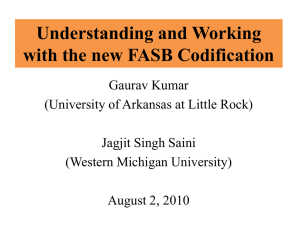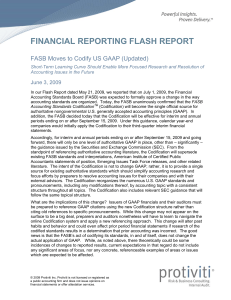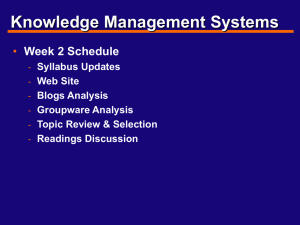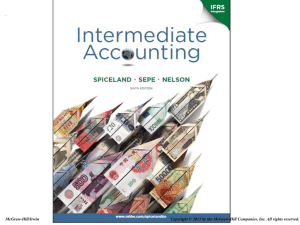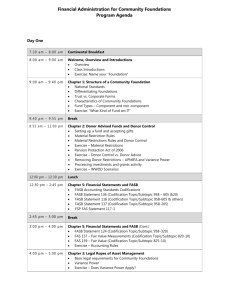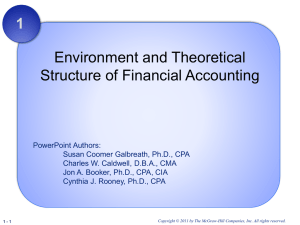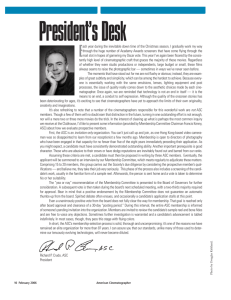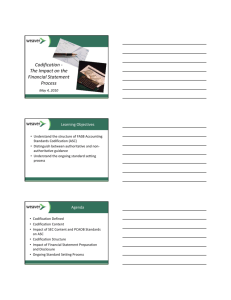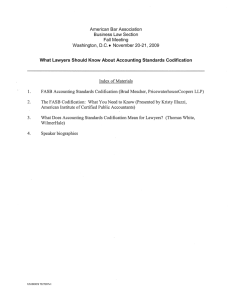Accounting Standards Codification: Introducing GAAP Research to
advertisement
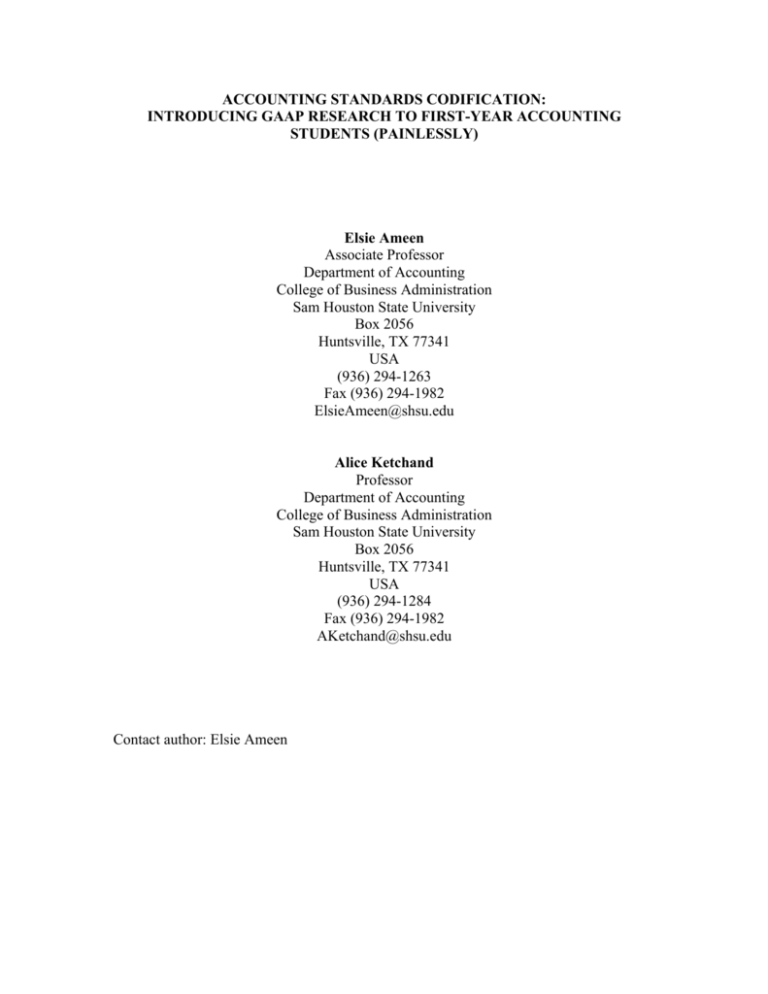
ACCOUNTING STANDARDS CODIFICATION: INTRODUCING GAAP RESEARCH TO FIRST-YEAR ACCOUNTING STUDENTS (PAINLESSLY) Elsie Ameen Associate Professor Department of Accounting College of Business Administration Sam Houston State University Box 2056 Huntsville, TX 77341 USA (936) 294-1263 Fax (936) 294-1982 ElsieAmeen@shsu.edu Alice Ketchand Professor Department of Accounting College of Business Administration Sam Houston State University Box 2056 Huntsville, TX 77341 USA (936) 294-1284 Fax (936) 294-1982 AKetchand@shsu.edu Contact author: Elsie Ameen ACCOUNTING STANDARDS CODIFICATION: INTRODUCING GAAP RESEARCH TO FIRST-YEAR ACCOUNTING STUDENTS (PAINLESSLY) PART 1 – INTRODUCTION Because of the previous nature of U.S. generally accepted accounting principles (GAAP) with its multiple, scattered sources and various formats, accounting principles students have generally experienced GAAP indirectly through textbooks or class lectures. Recent changes in structure make U.S. GAAP easily accessible to first-year accounting students. The FASB Accounting Standards Codification (ASC), the single source for authoritative nongovernmental U.S. GAAP beginning July 1, 2009, provides a new logical, topical format and the Codification Research System supplies an online tool not previously available for performing research. Now, directed research using the Codification Research System can connect even introductory students to the real-world source of GAAP. FASB has partnered with the American Accounting Association to make the ASC and Codification Research System available for educational use. The Professional Version of the Codification is available to accounting program faculty and students at an annual institutional fee of $150. See http://aaahq.org/FASB/Access.cfm for details. Accounting principles’ instructors can familiarize themselves with the organization of the ASC and the features of the Codification Research System using online tools provided by FASB. The home page of the ASC has a pdf document, Notice to Constituents, which provides detailed information on the history and goals of the project and the new organizational structure. Also on the home page is the link to a tutorial on how to use the Codification Research System. Briefly, the Accounting Standards Codification did not change existing US GAAP but reorganized it into roughly 90 accounting topics displayed using a consistent structure. The beginning point, shown to the far left on the home page, is the Area (e.g., Assets). Descending levels to add details (like an outline) include, Topics (e.g., Receivables), Subtopics (Overall), Section (Initial Measurement), perhaps a Subsection, and lastly Paragraph (e.g., Notes exchanged for cash). The citation system uses numbers associated with the different levels: topic, subtopic, section and paragraph. The citation for the string above is ASC 310-10-30-1. Features for finding information using the Codification Research System include a GO TO box to enter the citation (if known) in the ASC format; a Browse feature that lets a person dragging a mouse work through levels of Topic, Subtopic, Section, etc on the homepage; and Search and Advanced Search features for terms. A cross-reference feature (not useful for principles students) connects the old system of reference, e.g. FAS 125, with the location of the information in the ASC. PART 2 – USING THE ACCOUNTING STANDARDS CODIFICATION RESEARCH SYSTEM IN FIRST-YEAR ACCOUNTING CLASSES The tutorial available online may be helpful to students as well as faculty. Because they have little knowledge of GAAP, they can learn GAAP and the Codification Research System at the same time. The sample exercise below is designed to direct students to the answers using some of the basic research features: Browse, Go To, and Search. It identifies for the students the topic of interest and the nature of the issue. PART 3 – SAMPLE EXERCISE Topic: Current Assets and Current Liabilities Learning Objectives: Know the definitions of current assets and current liabilities and how the operating cycle affects the classification of assets and liabilities as current. Know how to present current assets and current liabilities on a balance sheet (statement of financial position) including required disclosures. One way to use the FASB Accounting Standards Codification is to browse the areas, topics, subtopics and sections (beginning with the buttons at the extreme left of the screen). Current assets and current liabilities are presented on the balance sheet. The financial statements are included in the Presentation area. The areas are not numbered, but the topics, subtopics, sections and paragraphs are numbered. On the home page of the Codification (http://asc.fasb.org/home), click on the Presentation tab on the far left of the screen. Then choose Topic 210 Balance Sheet and Subtopic 10 Overall. Click Section 20 Glossary. At the top of the page, you will see f page/print functions. Choose the printer friendly option from the drop down menu. Then highlight the definitions of current assets, current liabilities, and operating cycle. Copy these definitions (by right clicking your mouse and choosing copy) to a word document. You now have the information to meet the first learning objective. Another way to use the Codification is to go directly to the section or paragraph using the GO TO function. Close the f page/print functions window. In the GO TO box at the top left of the home page, enter 210-10-45-1. This will take you to the section on the classification of current assets and current liabilities. ASC 210-10-45-1 lists the items that are usually classified as current assets. What are these items? Use the GO TO box (or scroll down the page) to find ASC 210-10-45-3. This paragraph explains the time period used to determine whether an asset is current. What is the time period used? ASC 210-10-45-5 gives information related to the presentation of current liabilities on the balance sheet. What does this paragraph indicate must be included? ASC 210-10-50-1 gives information about required disclosures related to current assets. What types of disclosures must be included in financial statements related to current assets? PART 4: SOLUTION TO EXERCISE Current Assets Current assets is used to designate cash and other assets or resources commonly identified as those that are reasonably expected to be realized in cash or sold or consumed during the normal operating cycle of the business. See paragraphs 210-10-45-1 through 45-4. Current Liabilities Current liabilities is used principally to designate obligations whose liquidation is reasonably expected to require the use of existing resources properly classifiable as current assets, or the creation of other current liabilities. See paragraphs 210-10-45-5 through 45-12. Operating Cycle The average time intervening between the acquisition of materials or services and the final cash realization constitutes an operating cycle. ASC 210-10-45-1 Current assets generally include all of the following: • a. Cash available for current operations and items that are cash equivalents • b. Inventories of merchandise, raw materials, goods in process, finished goods, operating supplies, and ordinary maintenance material and parts • c. Trade accounts, notes, and acceptances receivable • d. Receivables from officers, employees, affiliates, and others, if collectible in the ordinary course of business within a year • e. Installment or deferred accounts and notes receivable if they conform generally to normal trade practices and terms within the business • f. Marketable securities representing the investment of cash available for current operations, including investments in debt and equity securities classified as trading securities under Subtopic 320-10 • g. Prepaid expenses such as the following: o 1. Insurance o 2. Interest o 3. Rents o 4. Taxes o 5. Unused royalties o 6. Current paid advertising service not yet received o 7. Operating supplies. ASC 210-10-45-3 A one-year time period shall be used as a basis for the segregation of current assets in cases where there are several operating cycles occurring within a year. However, if the period of the operating cycle is more than 12 months, as in, for instance, the tobacco, distillery, and lumber businesses, the longer period shall be used. If a particular entity has no clearly defined operating cycle, the one-year rule shall govern. ASC 210-10-45-5 A total of current liabilities shall be presented in classified balance sheets. ASC 210-10-50-1 It is important that the amounts at which current assets are stated be supplemented by information that reveals, for the various classifications of inventory items, the basis upon which their amounts are stated and, where practicable, indication of the method of determining the cost—for example, average cost, first-in first-out (FIFO), last-in first-out (LIFO), and so forth.

